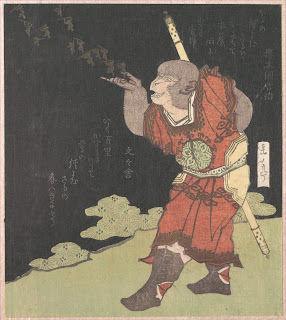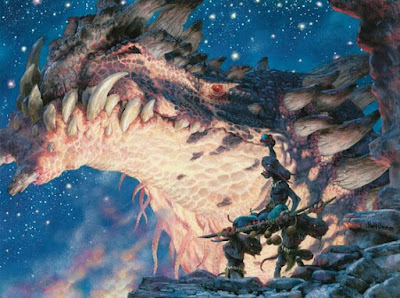On the Birth of God and Monkey Philosophy (Tales from the World Bloom 1)
In the beginning, Aman who Dreams the World looked upon the black seas of infinity and saw a tiny sparkling seed. He drew it up and saw that it was bright and fair like one of his own eyes. He planted it in his forehead and a flower grew. Plucking it, he found it had left behind a third eye. He returned the bloom to drift on the black seas.
It is upon this flower that our world came to be.
But that is of little interest to you, my dear one. I know you yearn for the whole story of Halar Serpentborn, Dragonslayer, Emperor of the Jeweled Throne, Bearer of the Words of Divinity, and Avatar of Aman. In my position as your tutor and tale weaver, I have not been afforded much time for study abroad, but because of your eager desire for learning, oh curious one, and your express command under penalty of death, I have scoured the five petals for the tales of Lord Halar.
It is my understanding that this is the first attempt that has been made at truly gathering together all the many different stories of Halar's journeys. Innumerable scrolls exist of his different adventures and many of these contradict each other and themselves to maddening degrees. This record will attempt to be accurate and comprehensive but it will inevitably be incomplete as anything accurate is incomplete, commenting on variations and contradictions where possible while still maintaining a coherent narrative. I know this is frustrating to you, my princess. As I quote, "Just tell me the truth, you miserable beetle!" Believe me, shining one, whatever frustration you feel over these contradictions, I feel thrice over. I shall endeavor to keep my interruptions to a minimum as we tell the story of the hero who saved our world all those years ago.
Halar's Journeys
Seyam was a serpent of brutal strength and cunning whose venom was death. All the Vatiar lived in fear of it, cowering in the trees or living in servitude to the snake. A foolhardy Satiar warrior, Rhudor Dawnbreaker, hears of the serpent and went in to kill it.
Rhudor put up a good fight but the serpent bit him and left him to die. But a Vatiar woman, Moon Shadow, found him and tried to save him. Over the weeks she tended to him, they fell in love but each day the venom grew stronger in his veins and each day time grew shorter and shorter. They are wed by the customs of the Vatiar in the last days they expected him to live.
But after their wedding night, the warrior seems cured and the elf knows she is with child. A mere 3 months later, Halar was born as if already sprinting into life. The demon Deneng who Closes the Mouth of the River came to kill the child upon his birth, but the goddess of life Vashrati who Sprinkles Morning Dew, appeared and spoke a Word of Divinity, "Hope," casting the demon into the depths and teaching the young Halar his first word. So Halar is born of the venom of the enemy and the words of the divine, thus the Night Folk called him Serpent Born.
Some of the scrolls of the nativity of the Lord Halar claim that since Moon Shadow is an avatar of Vashrati, the goddess herself did not appear, instead Moon Shadow herself beat the demon to death with her own hands, others say she ripped the demon’s head off.
The Journey of Many Monkeys:
At merely five years old, Halar was speaking in full sentences, or rather shouting as he bounded from tree to tree, louder and rowdier than any of the timid Wood Elves. At this great noise, the White Apes of Zhandabar came to see what was the matter. They saw the young hero and were greatly confused. He was light on his feet like one of them, loud like one of them, and even messy like one of them, yet he had no hair. The apes took him quietly and brought him before their wisest elders, but, as a child, Halar was a master of monkey philosophy and he stumped them all. Convinced he was the wisest being to ever live, they called him Bald One of Boundless Wisdom. They assigned their young prince, Hamadi, to follow him always and learn from him. So Hamadi became the infant Halar's first disciple.
On the first day of their journey, the pair found King Ghan of Sparkling Khandar, his carriage laden with gold, jewels, and orange blossoms.
This is the first mention of our own Sparkling Khandar, quite a different place than all those years ago, yet it would be this meeting that would one day lead to Halar taking the Jeweled Throne of Khandar and siring a dynasty that would last up until this present day, to you, my princess!
King Ghan was said to be the wisest of the Three Kings of the East and prouder than them all. So Halar said to Hamadi, "Watch this!"Halar bounded down from the trees, landing right before the carriage.
"Hail, wisest king of all the earth! If you are so wise, great king, answer me three questions!"
The king was surprised but he knew he could answer any questions this child put to him, for he was wise and proud of it! "Ask me any question, child!"
"And what will you give me if I can ask you a question you cannot answer, oh wise king?"



"instead Moon Shadow herself beat the demon to death with her own hands, others say she ripped the demon’s head off."
ReplyDeleteThis feels familiar and I just can't put my finger on where I've heard it before.
Love all of this, especially with the color commentary.
Thanks Dan! Your mythic stories definitely inspired me writing this. I thought the commentary would be a nice touch. I always love a nitpicking scholar in the margin. This one is a beetle-man fearing for his life from a petulant child princess.
DeleteI think I've read an earlier version of this you posted on one of the servers, but there are some things I don't remember seeing before. This story is really cool, and I like the way it ties together some aesthetics and themes from various mythologies and cultures, and has this very archetypal folklore feel.
ReplyDelete> ...as a child, Halar was a master of monkey philosophy
Definitely loled at this :P.
But ya, and the way the questions and the moral of it plays out at the end, it's all very fitting.
Thanks Max! It was definitely intended to be very archetypal as you say. The kids my wife teaches in first grade have definitely mastered monkey philosophy to her perpetual annoyance
Delete